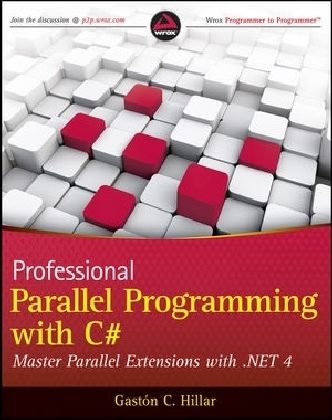
Professional Parallel Programming with C#
Wrox Press (Verlag)
978-0-470-49599-5 (ISBN)
- Titel ist leider vergriffen;
keine Neuauflage - Artikel merken
Expert guidance for those programming today s dual-core processors PCs As PC processors explode from one or two to now eight processors, there is an urgent need for programmers to master concurrent programming. This book dives deep into the latest technologies available to programmers for creating professional parallel applications using C#, .NET 4, and Visual Studio 2010. The book covers task-based programming, coordination data structures, PLINQ, thread pools, asynchronous programming model, and more. It also teaches other parallel programming techniques, such as SIMD and vectorization. * Teaches programmers professional-level, task-based, parallel programming with C#, .NET 4, and Visual Studio 2010 * Covers concurrent collections, coordinated data structures, PLINQ, thread pools, asynchronous programming model, Visual Studio 2010 debugging, and parallel testing and tuning * Explores vectorization, SIMD instructions, and additional parallel libraries Master the tools and technology you need to develop thread-safe concurrent applications for multi-core systems, with Professional Parallel Programming with C#.
Gaston C. Hillar is an independent software consultant who has been researching parallel programming, multiprocessor, and multicore since 1997. He has years of experience designing and developing diverse types of complex parallelized solutions that take advantage of multiple processing cores with C# and .NET Framework.
FOREWORD xix INTRODUCTION xxi CHAPTER 1: TASK-BASED PROGRAMMING 1 Working with Shared-Memory Multicore 2 Differences Between Shared-Memory Multicore and Distributed-Memory Systems 3 Parallel Programming and Multicore Programming 4 Understanding Hardware Threads and Software Threads 5 Understanding Amdahl s Law 10 Considering Gustafson s Law 13 Working with Lightweight Concurrency 16 Creating Successful Task-Based Designs 17 Designing With Concurrency in Mind 18 Understanding the Differences between Interleaved Concurrency, Concurrency, and Parallelism 19 Parallelizing Tasks 19 Minimizing Critical Sections 21 Understanding Rules for Parallel Programming for Multicore 22 Preparing for NUMA and Higher Scalability 22 Deciding the Convenience of Going Parallel 27 Summary 28 CHAPTER 2: IMPERATIVE DATA PARALLELISM 29 Launching Parallel Tasks 30 System.Threading.Tasks.Parallel Class 31 Parallel.Invoke 32 No Specific Execution Order 33 Advantages and Trade-Off s 37 Interleaved Concurrency and Concurrency 38 Transforming Sequential Code to Parallel Code 40 Detecting Parallelizable Hotspots 40 Measuring Speedups Achieved by Parallel Execution 43 Understanding the Concurrent Execution 45 Parallelizing Loops 45 Parallel.For 46 Refactoring an Existing Sequential Loop 48 Measuring Scalability 50 Working with Embarrassingly Parallel Problems 52 Parallel.ForEach 52 Working with Partitions in a Parallel Loop 54 Optimizing the Partitions According to the Number of Cores 56 Working with IEnumerable Sources of Data 58 Exiting from Parallel Loops 60 Understanding ParallelLoopState 62 Analyzing the Results of a Parallel Loop Execution 63 Catching Exceptions that Occur Inside Parallel Loops 64 Specifying the Desired Degree of Parallelism 66 ParallelOptions 66 Counting Hardware Threads 69 Logical Cores Aren t Physical Cores 70 Using Gantt Charts to Detect Critical Sections 71 Summary 72 CHAPTER 3: IMPERATIVE TASK PARALLELISM 73 Creating and Managing Tasks 74 System.Theading.Tasks.Task 75 Understanding a Task s Status and Lifecycle 77 TaskStatus: Initial States 77 TaskStatus: Final States 78 Using Tasks to Parallelize Code 78 Starting Tasks 79 Visualizing Tasks Using Parallel Tasks and Parallel Stacks 80 Waiting for Tasks to Finish 85 Forgetting About Complex Threads 85 Cancelling Tasks Using Tokens 86 CancellationTokenSource 89 CancellationToken 89 TaskFactory 90 Handling Exceptions Thrown by Tasks 91 Returning Values from Tasks 92 TaskCreationOptions 95 Chaining Multiple Tasks Using Continuations 95 Mixing Parallel and Sequential Code with Continuations 97 Working with Complex Continuations 97 TaskContinuationOptions 98 Programming Complex Parallel Algorithms with Critical Sections Using Tasks 100 Preparing the Code for Concurrency and Parallelism 101 Summary 101 CHAPTER 4: CONCURRENT COLLECTIONS 103 Understanding the Features Offered by Concurrent Collections 104 System.Collections.Concurrent 107 ConcurrentQueue 107 Understanding a Parallel Producer-Consumer Pattern 111 Working with Multiple Producers and Consumers 115 Designing Pipelines by Using Concurrent Collections 120 ConcurrentStack 121 Transforming Arrays and Unsafe Collections into Concurrent Collections 128 ConcurrentBag 129 IProducerConsumerCollection 136 BlockingCollection 137 Cancelling Operations on a BlockingCollection 142 Implementing a Filtering Pipeline with Many BlockingCollection Instances 144 ConcurrentDictionary 150 Summary 155 CHAPTER 5: COORDINATION DATA STRUCTURES 157 Using Cars and Lanes to Understand the Concurrency Nightmares 158 Undesired Side Effects 158 Race Conditions 159 Deadlocks 160 A Lock-Free Algorithm with Atomic Operations 161 A Lock-Free Algorithm with Local Storage 162 Understanding New Synchronization Mechanisms 163 Working with Synchronization Primitives 164 Synchronizing Concurrent Tasks with Barriers 165 Barrier and ContinueWhenAll 171 Catching Exceptions in all Participating Tasks 172 Working with Timeouts 173 Working with a Dynamic Number of Participants 178 Working with Mutual-Exclusion Locks 179 Working with Monitor 182 Working with Timeouts for Locks 184 Refactoring Code to Avoid Locks 187 Using Spin Locks as Mutual-Exclusion Lock Primitives 190 Working with Timeouts 193 Working with Spin-Based Waiting 194 Spinning and Yielding 197 Using the Volatile Modifier 200 Working with Lightweight Manual Reset Events 201 Working with ManualResetEventSlim to Spin and Wait 201 Working with Timeouts and Cancellations 206 Working with ManualResetEvent 210 Limiting Concurrency to Access a Resource 211 Working with SemaphoreSlim 212 Working with Timeouts and Cancellations 216 Working with Semaphore 216 Simplifying Dynamic Fork and Join Scenarios with CountdownEvent 219 Working with Atomic Operations 223 Summary 228 CHAPTER 6: PLINQ: DECLARATIVE DATA PARALLELISM 229 Transforming LINQ into PLINQ 230 ParallelEnumerable and Its AsParallel Method 232 AsOrdered and the orderby Clause 233 Specifying the Execution Mode 237 Understanding Partitioning in PLINQ 237 Performing Reduction Operations with PLINQ 242 Creating Custom PLINQ Aggregate Functions 245 Concurrent PLINQ Tasks 249 Cancelling PLINQ 253 Specifying the Desired Degree of Parallelism 255 WithDegreeOfParallelism 255 Measuring Scalability 257 Working with ForAll 259 Differences Between foreach and ForAll 261 Measuring Scalability 261 Configuring How Results Are Returned by Using WithMergeOptions 264 Handling Exceptions Thrown by PLINQ 266 Using PLINQ to Execute MapReduce Algorithms 268 Designing Serial Stages Using PLINQ 271 Locating Processing Bottlenecks 273 Summary 273 CHAPTER 7: VISUAL STUDIO 2010 TASK DEBUGGING CAPABILITIES 275 Taking Advantage of Multi-Monitor Support 275 Understanding the Parallel Tasks Debugger Window 279 Viewing the Parallel Stacks Diagram 286 Following the Concurrent Code 294 Debugging Anonymous Methods 304 Viewing Methods 305 Viewing Threads in the Source Code 307 Detecting Deadlocks 310 Summary 316 CHAPTER 8: THREAD POOLS 317 Going Downstairs from the Tasks Floor 317 Understanding the New CLR 4 Thread Pool Engine 319 Understanding Global Queues 319 Waiting for Worker Threads to Finish Their Work 329 Tracking a Dynamic Number of Worker Threads 336 Using Tasks Instead of Threads to Queue Jobs 340 Understanding the Relationship Between Tasks and the Thread Pool 343 Understanding Local Queues and the Work-Stealing Algorithm 347 Specifying a Custom Task Scheduler 353 Summary 359 CHAPTER 9: ASYNCHRONOUS PROGRAMMING MODEL 361 Mixing Asynchronous Programming with Tasks 362 Working with TaskFactory.FromAsync 363 Programming Continuations After Asynchronous Methods End 368 Combining Results from Multiple Concurrent Asynchronous Operations 369 Performing Asynchronous WPF UI Updates 371 Performing Asynchronous Windows Forms UI Updates 379 Creating Tasks that Perform EAP Operations 385 Working with TaskCompletionSource 394 Summary 398 CHAPTER 10: PARALLEL TESTING AND TUNING 399 Preparing Parallel Tests 399 Working with Performance Profi ling Features 404 Measuring Concurrency 406 Solutions to Common Patterns 416 Serialized Execution 416 Lock Contention 419 Lock Convoys 420 Oversubscription 423 Undersubscription 426 Partitioning Problems 428 Workstation Garbage-Collection Overhead 431 Working with the Server Garbage Collector 434 I/O Bottlenecks 434 Main Thread Overload 435 Understanding False Sharing 438 Summary 441 CHAPTER 11: VECTORIZATION, SIMD INSTRUCTIONS, AND ADDITIONAL PARALLEL LIBRARIES 443 Understanding SIMD and Vectorization 443 From MMX to SSE4.x and AVX 446 Using the Intel Math Kernel Library 447 Working with Multicore-Ready, Highly Optimized Software Functions 455 Mixing Task-Based Programming with External Optimized Libraries 456 Generating Pseudo-Random Numbers in Parallel 457 Using Intel Integrated Performance Primitives 461 Summary 468 APPENDIX A: .NET 4 PARALLELISM CLASS DIAGRAMS 469 Task Parallel Library 469 System.Threading.Tasks.Parallel Classes and Structures 469 Task Classes, Enumerations, and Exceptions 471 Data Structures for Coordination in Parallel Programming 472 Concurrent Collection Classes: System.Collections.Concurrent 474 Lightweight Synchronization Primitives 476 Lazy Initialization Classes 477 PLINQ 477 Threading 479 Thread and ThreadPool Classes and Their Exceptions 479 Signaling Classes 479 Threading Structures, Delegates, and Enumerations 480 BackgroundWorker Component 486 APPENDIX B: CONCURRENT UML MODELS 487 Structure Diagrams 487 Class Diagram 487 Component Diagram 489 Deployment Diagram 489 Package Diagram 489 Behavior Diagrams 489 Activity Diagram 491 Use Case Diagram 491 Interaction Diagrams 493 Interaction Overview Diagram 493 Sequence Diagram 494 APPENDIX C: PARALLEL EXTENSIONS EXTRAS 497 Inspecting Parallel Extensions Extras 497 Coordination Data Structures 502 Extensions 507 Parallel Algorithms 513 Partitioners 516 Task Schedulers 517 INDEX 521
| Sprache | englisch |
|---|---|
| Maße | 195 x 237 mm |
| Gewicht | 974 g |
| Themenwelt | Informatik ► Programmiersprachen / -werkzeuge ► C# |
| Informatik ► Software Entwicklung ► Objektorientierung | |
| ISBN-10 | 0-470-49599-5 / 0470495995 |
| ISBN-13 | 978-0-470-49599-5 / 9780470495995 |
| Zustand | Neuware |
| Haben Sie eine Frage zum Produkt? |
aus dem Bereich


